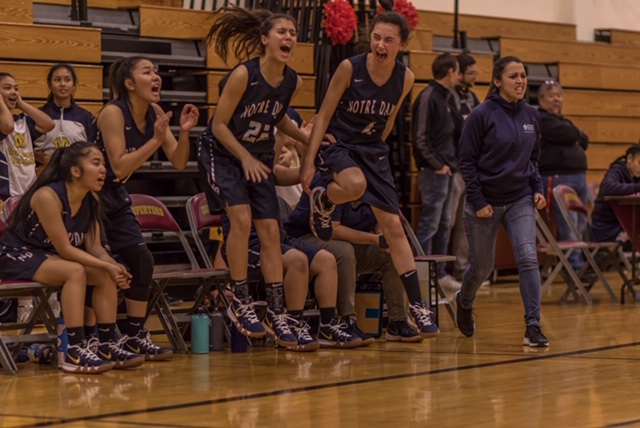Women in Sports: Role Models for Life
Pictured: Head varsity coach, Ali Bueno with the Regents of Notre Dame High School in San Jose, CA
By Sophia Arenas
Historically in sports, women have had and continue to have many obstacles to overcome. They often have been scrutinized for their appearance; either criticized for their lack of femininity or hyper-sexualized in the media and on the cover of magazines. Before the passage of Title IX in 1972, about 1 in 27 women participated in sports. Today 2 in 5 women participate in athletics. Media coverage does not reflect this dramatic increase, however, and despite the drastic increase in participation rates female athletes are still covered less, and less seriously, than male athletes. For example, the US women’s basketball team won their fifth consecutive gold medal in 2012 at the summer Olympics but received less than half of a minute in prime-time coverage. The men’s team, however, who won their second consecutive gold medal, received approximately half of an hour of prime-time coverage (1).
More recently, the U.S. Women’s soccer team (led by co-captains, Alex Morgan, Megan Rapinoe and more) filed a gender discrimination lawsuit in March 2019. As stated in the lawsuit, “...Despite the fact that these female and male players are called upon to perform the same job responsibilities on their teams and participate in international competitions for their single common employer, the USSF, the female players have been consistently paid less money than their male counterparts.” This discrimination is not only apparent in terms of pay and media coverage, but also in terms of medical treatment, types of training and coaching they recieve, and means of transportation to matches, despite the U.S. Women’s National Team being world champions.
Over the years many women have paved the way for the next generation of athletes. They have been role models for little girls who have grown up watching them, even when the athletes didn’t realize they were being idolized. They are the pioneers who made it possible for contemporary sports stars like Serena Williams, Diana Taurasi, Megan Rapinoe and Alex Morgan. Although these women or athletes, in general, may not have signed up to be role models, the reality is that they are in the public eye and will be looked up to by a whole new generation of young girls.
Indeed, female athletes do serve as powerful role models for young girls; they promote a healthy lifestyle and participation in physical activity. Not only do female athletes promote a healthy lifestyle but also defy stereotypes of what society believes a female body should look like. They are strong, which sends the message to young girls that it is possible to have muscles and still be feminine. It shows young girls that their value as a woman is not defined by the number on a scale.
Females who participate in sports also develop important life skills such as confidence, dedication, leadership, the ability to work in groups, and more. Sports for many can be that initial platform where young people acquire these necessary tools to succeed in the world. However, in the past, boys were encouraged to participate in sports while females were encouraged to participate in more “gender appropriate” activities. Although the idea that sports should only be reserved for boys/men is certainly outdated, it has much to do with the efforts made by female sports pioneers who paved the way for the next generation. The media heavily influences how females participate and how they perceive their role in sport. Less than 10% of sports media covers women’s sports and less than 2% of sports media covers women’s sports that are deemed too masculine (2).
As a society we have made significant growth in our ability to value diversity; however, we still have a long way to go, especially regarding the #metoo movement. Gender roles are deeply rooted in our culture; we see their influences permeate through sport every day. From the ground up young girls need to be offered the opportunity to participate in sports of all kinds - masculine or feminine. They need to be led by female coaches in order to foster their perception of their future selves. The media, being one of the heaviest influencers, needs to equalize their sports coverage and spotlight strong, elite female athletes. Without consistent exposure to the excellence of female athletics, the masculine-heavy perspective in sports coverage will never change. Leveling the playing field in sports could be a stepping stone to the ultimate goal: gender balance throughout wider society.
Coche, R. & Tuggle, C. A. (2016). The women’s Olympics?: A gender analysis of NBC’s coverage of the London 2012 Summer Games. Electronic News, 10(2), 121-138.
Koivula, N. (1999). Gender stereotyping in televised media sport coverage. Sex Roles, 41(7), 589-604.











